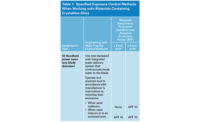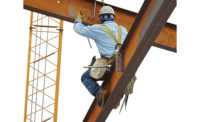Falls are the leading cause of death among private industry construction workers. This isn’t a surprise considering the duty to provide fall protection is traditionally the most frequently cited OSHA construction violation.
OSHA requires the use of fall protection when working at heights of six feet or greater above a lower level (and at any height above dangerous equipment) at all construction jobsites under CFR 1926 Subpart M, “Fall Protection.” Fall protection systems and procedures prevent workers from falling off, onto, or through walking-working surfaces and protect workers from falling objects.
Potential hazards
OSHA recognizes that accidents involving falls are generally complex events frequently involving a variety of factors. Consequently, the standard for fall protection deals with both human and equipment related issues in protecting workers from fall hazards.
There are three main hazard areas: unsafe environment, unsafe equipment, and unsafe behavior.
- Unsafe environment: Many times, the environment creates the fall hazard. Snow, mist, or rain could cause a walking surface to become slippery, increasing the likelihood of a fall.
- Unsafe equipment: Sometimes, the equipment itself creates a hazard. For example, a broken guardrail or damaged harness could fail at providing adequate protection.
- Unsafe behavior poses a potential hazard. For instance, if an employee doesn’t tighten the leg straps of their harness appropriately and falls, serious injuries may occur. Also, if they fail to properly tie off a lanyard, go beyond warning lines, or climb over a guardrail they can suffer the consequences.
Fall protection systems
Employers must determine the appropriate fall protection method or system that best suits the jobsite and type of work operation. Some examples include:
- Guardrail systems (erected barriers) are a common method on construction jobsites for protecting workers from falling.
- Safety net systems are used to protect employees from hazardous vertical drops.
- Covers are secured, removable caps used to protect employees from falling into holes in floors, roofs, skylights, manholes, pits, and other walking-working surfaces.
- Personal fall arrest systems are used to arrest (halt) a falling worker. They must be inspected prior to each use for wear and tear. Fall arrest systems consist of a body harness, anchorage, and connectors. They may also include a lanyard, deceleration device, or lifeline.
- A positioning device system is a body harness system rigged to allow a worker to be supported on an elevated vertical surface such as a wall, and work with both hands free while leaning. Employees are always in a fixed position and cannot move freely as when wearing a personal fall arrest or travel restraint system.
Training
Remember, unsafe environments, equipment, and behavior can all contribute to employee injuries. That’s why it’s an OSHA requirement to provide training on how to recognize and minimize fall hazards to all employees who may be exposed.
This training must include how to correctly use, operate, install, maintain, dismantle, and inspect fall protection systems. Retrain employees when the situation requires it.
Finally, OSHA requires employers to prepare a written certification record after the training is completed.
Inspecting fall protection
Inspections help workers identify and correct problems before they cause any harm.
A best practice is to inspect all fall protection equipment daily, but certain equipment requires an inspection before every use, like when using personal fall protection. Ensure employees visually inspect their fall protection systems and equipment for any damage, deterioration, or broken parts.


